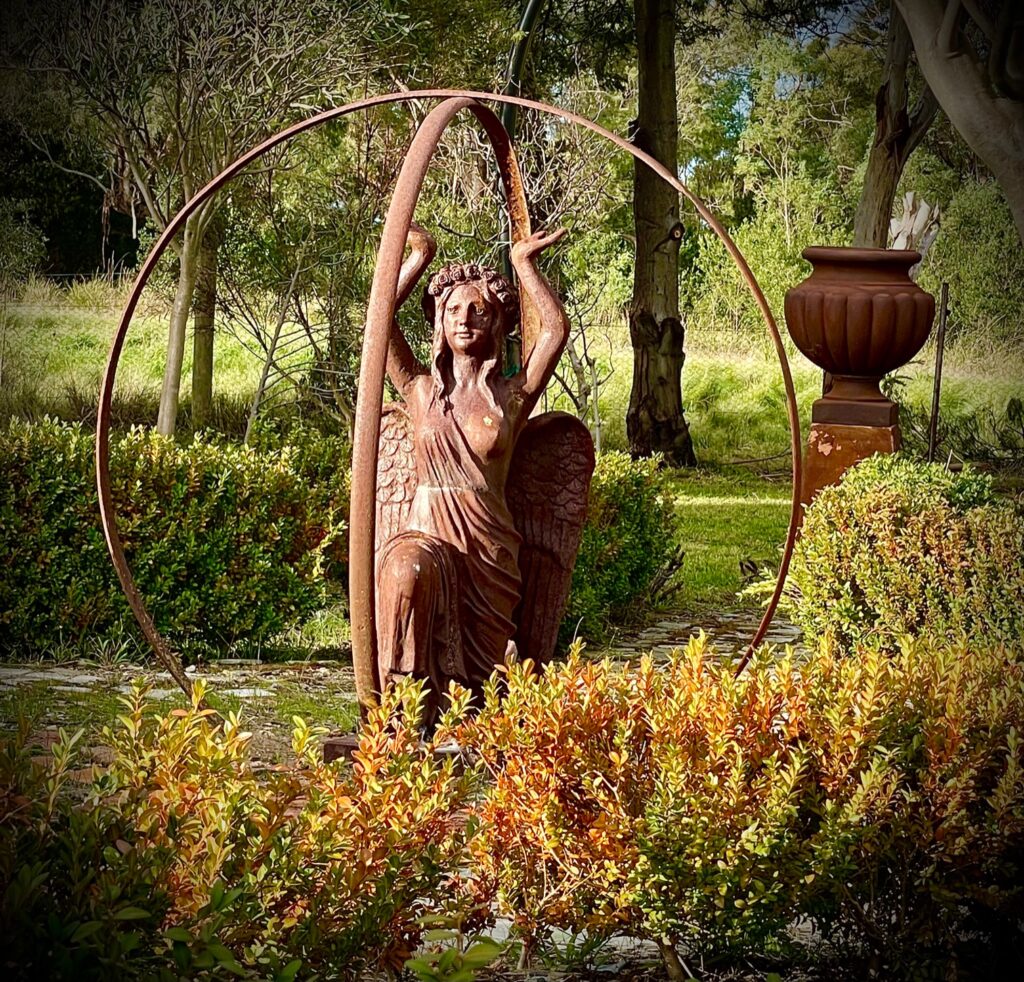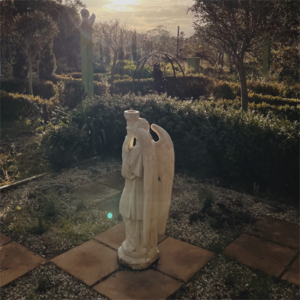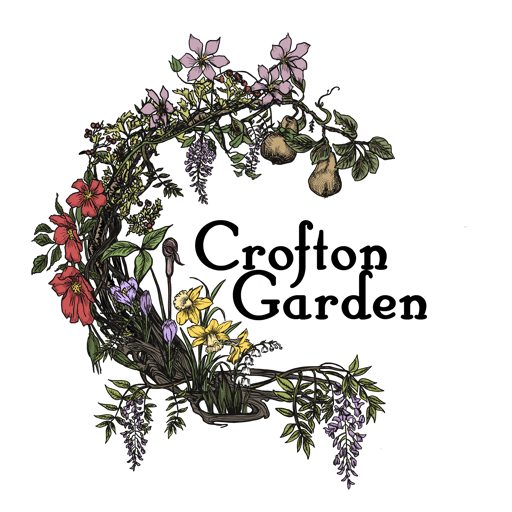Walk the Garden

Shall we take a walk around our Garden? Of course, it is not the same as visiting and seeing it in real life but it will give you an idea. It’s a lovely sunny day. Let’s start through the side gate leading to the South Garden, flanked by white miniature Agapanthus in dark grey urns on each side, box hedges and a row of the lovely rose ‘Margaret Merrill’. A charming start, even if I do say so myself…
The South Garden

Another name for this garden could be the Woodland Garden as it is where we have planted mostly shade and moisture loving plants. Being on the South side of the house it is well protected from the sun and wind. Small trees and shrubs, such as the stunning Styrax japonica, brightly coloured Acers, Cornus and Magnolia frame the back of the bed, underplanted with Hellebores, Trilliums, Trycertis, three kinds of Paeonies, Lilies and many other little jewels that pop up each year.
Box hedges run down the front of the Garden and are used to form a circle in the middle entrance. This is protecting a rare Jacaranda ‘White Christmas’, which we were sold accidently by a Nursery that wasn’t supposed to have it except the wholesaler mistakenly added it to their order and by the time they realised Jenny had spotted, bought and planted it. We haven’t had much success with Jacarandas in the past but we’re always hopeful.
In filling between all this loveliness is Geranium maderense ‘Alba’, who needs to be kept far away from the other Geranium maderense in the garden as the promiscuous little souls like to cross pollinate and we’d hate to lose the white form.
Down the path avoiding having your eye poked out by the Japanese Maples, you walk through the gate guarded by our Chinese Dog.
The ‘Front’ Garden

The ‘Front’ Garden name is mocked as Jenny never calls it the front. In fact, when she says Front Garden no one ever knows which bed she is talking about. None the less, we shall persevere with the names we have chosen.
This area is a meandering mix of small trees, shrubs, perennials and bulbs. Dominating the entry, after admiring the weeping Beech and Pulmonaria collection, is the Teahouse. This is filled with Bonsai, a few ferns and slowly being covered by a pink Wisteria and ‘Constance Spry’ rose, it’s a mix of Japanese and Victorian aesthetics may seem strange to some but it works for us. And no Teahouse is complete without a pond, we have surrounded ours with mosses, Acers and a highly annoying Bamboo grass that the nursery claimed wasn’t invasive but turned out to be REALLY invasive. Moving on.
The Silver Birch grove shades an extensive collection of Epimediums, along with other woodlanders, such Cyclamen and Hepaticas. Directly in front of the house are two large beds filled with Viburnums, Cornus, Philadelphus, Robinia, Cercis, you get the idea. These are underplanted with Geranium phaem, Erythronium, Muscari and other various bulbs.
The large Lonicera topiary ‘shape’ is a beast of its own making. After various reincarnations it has emerged triumphantly by what can only be described as a modern sculpture masterpiece in the vein of Henry Moore or Barbara Hepworth. Best to just admire it and move on.
A brief stop at the Round Pond Seat, happily situated in naturalised Sporaxis, which is filled with Japanese Irises and a sleeping cherub, we turn the corner into the Side Pond Garden, making sure that we admire the bark on the Tibetan Cherry Trees as we go. Keen eyes will spy the Golden Willow that has been coppiced and behind that an extremely rare Pink Birch that Jenny has tended and loved forever.
Side Pond Garden

This garden has been transformed recently by the removal of a weeping cherry that dominated the gravel ‘beach’. It is always slightly disturbing removing a tree, but the area it opened up has allowed us to take advantage of the shady site. Of particular note is a clump of Corydalis ‘Porcelain Blue’ which contrasts beautifully with Anthriscus sylvestris ‘Golden Fleece’. Along with this new development we have a range of plants from Arum proboscideum (the Mouse Plant), Pulmonarias, through to Rheum palmatum, Clematis armandii ‘Apple Blossom’ and the stunning double Wisteria ‘Black Dragon’.
Formal elements are represented by the Lilly Pilly standard topiaries, and the Lonicera hedging. The bed that runs down the veranda is a mixed bag of goodies, the most obvious are our two different species of Brunsvigia, one is the more common B. jospehinae (the Josephine Lily), the other is B.grandiflora ( a lovely pink). Other plants just self-seed themselves about as the Nicotiana’s and Lupins demonstrate semmingly growing out of every nook and cranny they can find but never where you either want or plant them. Go figure.
Filling in these beds is a range of small trees (Cornus, Acer, a weeping lollipop Golden Ash, Magnolia) shrubs (Persian Lilac, Camellias, Viburnum, Philadelphus, Sambucus), perennials (Echium, Euphorbia, Hellebores, Canna ‘Stuttgart’) and bulbs (Lilies, Erythronium). A new bubbling fountain creates a lovely focal point under the weeping Golden Ash.
Chubby Cherub Fernery

Through the archway you stumble across a small seating and BBQ area, protected by a Pittospernum hedge. A series of archways bearing Roses and Clematis enclose the pathway, but look to your left and you will see our little Chubby Cherub sitting amongst the shade loving plants.
A lack lustre Fernery fills this shady area, along with varieties of Podaphyllums, Trilliums and Hellebores, that are doing much better than the ferns. The real gem in this garden is the delicate golden Japanese Flame tree – Zelkova serrata. It’s one of Jenny’s favourite trees in the garden.
Back Veranda Gardens

These garden beds were the first we developed due to their proximity to the house, water and some shade. They have also changed a great deal over time. Magnolias, Viburnums, Cornus, Brugmansia and Prunus have been planted for shade and height, underplanted with Spuria, Pieris, Elysiums, Arisarum, Roses, Mahonias, all have been crammed in and fight for space. And, of course, assorted bulbs popping up.
The walkway between the beds (towards the house) reveals our plight to grow Japanese Maples at the beginning of the garden. All were kept planted in pots as the only way we could keep them alive and their growth and health today is a testament to Jenny’s determination that they WILL survive. Hidden along with them are a number of delightful gems such as Lapagerias, Corydalis and others that have not yet found a place in the garden, or need to have an eye (and water) kept on them.
Conifer Bed

The Conifer Bed on the left side of the garden is a lovely mix of colours, textures and sizes. What is also lovely about Conifers is that the display is evergreen.
In this bed we have Japanese Pines, Spruces, Junipers,Cypresses, you know, conifers…
Grass Bed

There are always those garden beds that are nothing but trouble. This is ‘that’ bed. It is also at the bottom of the garden so you tend not to think about it much. Over the years we have tried a number of plants and ideas, finally settling on ‘grasses’. The soil is atrocious but we keep putting compost on it so hopefully one day it may actually retain some moisture. Still, it’s better than it was. Phormiums are the main feature here with other more ‘delicate’ grasses planted in between, along with Sedums. Holly has always loved Alliums but we’ve never had much success so she decided to make some for Jenny’s birthday one year. Her dream is to have them swaying over the phormiums and grasses as the real ones are seen in gardening magazines. It may work, it may not, we’ll just have to wait and see. A Gymea Lily is also hidden away in this bed as it’s source was dubious and Jenny refuses to say where she got it from.
The Glasshouse
It’s a bit of an eyesore to be honest so best we just move past it.

Parterre Garden
Another current work in progress is the Parterre Garden. It is one of the original garden beds we put in but the fillers of the formal beds have changed over time. Its soil type can be discerned by the fact that the Olive Trees love it.
In the past we had tried a mixed cottage border, herbs, all kinds of things. A decision was made to simply fill the beds with Santolina to create a wonderful silver contrast to the green Buxus hedges, and we are pleased to say that this has been quite the success in our eyes.
The Folly
Who would be without a Folly? Obviously not us. We built this ‘ruin’ as somewhere to put our ‘Gothic’ windows. It’s quite nice to have a seat inside and look out.
An angel sits in the middle of a small ‘chessboard’ pattern, which has had a number of reincarnations but at the moment has some Thyme growing in it quite happily.

Dry Garden

If you keep walking across the back of the Garden you will find the Snail Hunters Pond which leads you to our ‘Dry’ Garden. To be completely honest all the beds down the back of the garden are dry, but this one holds the title. It has some really interesting plants in it though, Acacia aphylla is the spiky shrub over the back corner, Agaves are nestled under the Eucalypt near the front, a weeping Acacia and Grevillea are centre middle, Euphoriba rigida emerges throughout the bed as a welcomed fillerand species miniature Narcissus pop up all over the front. Along with the Grass Bed it is a running experiment but sometimes they turn out to be the best ones.
Fountain Garden

We love our Fountain. After years of inactivity, we finally persuaded the old girl to start working again, and what a difference it makes to the garden.
This is a formal style garden, with box hedges, conifer balls and boldly defined entrance points. Espaliered Malus ioensis flora plena run the perimeter of the beds, some of these are successful, some not so much but it’s hard to keep your eye on everything in such a large garden so we do the best we can.
But it’s the beds where all the excitement breaks loose. A cottage garden at heart, it has anything and everything packed into it. Roses and Pandoreas climb the arches (and hopefully one day clamber along the wires connecting the two). Roses are also in the beds, along with Echinops, Erygium, Larkspur, Maclaeya, Centaurea, Silene, Saliva, Delphiniums, even the odd Hebe – the list goes on and on. A wonderful abundance of chaos and wildness, and let’s not forget the delicious Elephant Garlic popping up everywhere.
Stone Wall Garden

This garden holds a special place as it is named after one of the first major projects we completed together. The Stone Wall was our victory against the ravages of a drought and shelter for our plants to claim a chance at survival. We built it in 6 weeks, it nearly killed us but here, 20 years later, it stands as a reminder of hard work, the preciousness of our plants and of our stubbornness and resilience in the face of imminent failure.
As with all the garden beds here, it has grown over time, helped along by Jenny’s technique of shovelling the edges to give them a clean line after she’s weeded them, making for some very interesting pathways as well.
But back to the plants. Robinias and Birches have grown (and self-seeded) here to create some shade where once there was none. In front of this is a collection of Paeonies, Lilies, Arums, Foxgloves, Cerinthe, and Poppies. A large shrub of Acanthus ‘Hollands Gold’ dominates the centre.
In the far Stone Wall corner is filled with Jenny’s Brugmansia collection. The large Peppercorn was planted when the house was built over 100 years ago and is precious to us.
Under the Peppercorn is another of our rare shaded areas, relatively untouched by sun, so, of course, we fill it with Arums, Arisarums, Arisaemas (Jenny’s true love), Podophyllums and Myosotidums. The few larger plants we have in here is a luminous Philadephus aurea, a delightful Lamium orvala, who pops up each year, and the slightly thuggish Geranium maderense and the extremely thuggish Acanthus.
The Infamous Middle Bed

It’s huge, it’s temperamental and no one ever wants the job of weeding it, but it’s a mixed bed of goodness too despite being out of control and no one knowing what to do with it – at least that’s what we said last year. This year the Middle Bed had a makeover. We were trying to make the bed smaller so we cut it up into three parts using pathways and moved the arch structure into the centre, creating an almost Escher like effect as you walk around it. We kept the key trees are a pair of Gleditsia, Prunus, the Weeping Elm, Manchurian and Capital Pears and Malus. The seat in the middle is quite a lovely place to sit these days.
The rest of the planting is new as you can probably tell, with small shrubs and trees being planted to try to make it less work, we’ll see how that goes…
Pleached Elm Tunnel
It’s one way to make an entrance. Ulmus purpurescens trees have been trained to form a square arch over the path, with a Buxus hedge running along the edge. There are a number of small treasures in the sandstone troughs, where Jenny has planted Hepaticas, a fringed Corydalis, Dianthus ‘Miss Essie’, mini species Iris and any other bulbs left over. We’re constantly surprised at what comes up. And we’re constantly surprised at the things that survive in the garden too but that’s gardening for you. A constant shock.
